10 Key Steps To Building A Winning Go-To-Market Strategy
Your go-to-market strategy (GTM) will be crucial to your product’s success. Currently, the digital advertising and marketing sector is booming, with projections of an astounding $947 billion by 2027. There’s no wonder why startups are flooding the market, all eager to tap into this well of wealth.
However, 90% of startups fail. A contributing factor to this high failure rate is companies’ tendency to overly fixate on developing the next ground-breaking product. This typically happens when startups lose sight of one of the most critical components to build a sustainable business. We’re talking about go-to-market strategy, which many companies have used to achieve paramount success.
Table of Contents
What is a go-to-market strategy?
A go-to-market approach is a comprehensive plan businesses use to launch a new product and drive demand. This plan acts like a roadmap for a successful product launch and involves critical decisions. These decisions include defining the target market, developing an in-depth customer understanding, and setting price strategies. Ultimately, a GTM strategy directs the entire organisation and aligns them towards introducing the product to their customers.
The go-to-market strategy essentially answers the question:
How will we take our product from development to the hands of our customers?
Effective product managers treat a well-crafted go-to-market strategy like a GPS that would help them navigate product launch complexities. It’s a crucial master plan to guide every step the organisation takes, from development to market adoption.
What is the purpose of a go-to-market strategy?
A go-to-market strategy ensures your product’s successful launch and sustained growth. This is achievable when the company optimises their processes and minimises the risks they take. It is a meticulously crafted roadmap outlining crucial steps and decisions for a seamless market entry. Ultimately, a well-prepared GTM strategy anticipates the challenges of entering a competitive market.
Who is responsible for a go-to-market strategy?
Usually, the go-to-market manager oversees the GTM strategy and product launches. Their key tasks include collaborating with cross-functional teams to ensure streamlined launch operations. They’re also in charge of defining the strategic vision, hiring the team, and driving their motivations to execute operational initiatives. Lastly, their reporting lines typically lead to either the Head of Marketing or Product.
Why is a go-to-market strategy important?
A go-to-market strategy addresses common missteps businesses make, especially in startups. Many founders create products to solve problems, assuming their market will immediately understand and adopt the solution. This assumption often leads them to prioritise their go-to-market strategy lower in their list of priorities. This can be a significant mistake with potentially dire consequences for the business.
An example of a market strategy’s usefulness
Let’s put it in perspective using an example.
Let’s say you’re an app developer who creates a tool for tracking calories and finding healthy options in fast-food restaurants.
Technically, you’ve built an app to cater to your needs for healthy eating at fast food joints. You thought people would readily see the app’s value just like you did. But once the app is fully developed, it quickly becomes evident there’s no need for such a solution.
Why?
It’s because the people who follow diet plans most likely won’t dine in fast food restaurants. A well-crafted go-to-market strategy could’ve quickly revealed these flaws. It could’ve guided you to identify a niche market or make the product appealing to its target segments.
A go-to-market strategy helps avoid product development potholes
A go-to-market strategy can be an indispensable guide and fallback tool for companies. It’s a concise plan that highlights all the nuances of a product or service. This strategy plays a multifaceted role that allows businesses to navigate the challenges of the market and secure their success.
What are the benefits of go-to-market strategy?
A GTM strategy offers several key benefits for businesses, particularly when launching a new product or entering a new market. These benefits include:
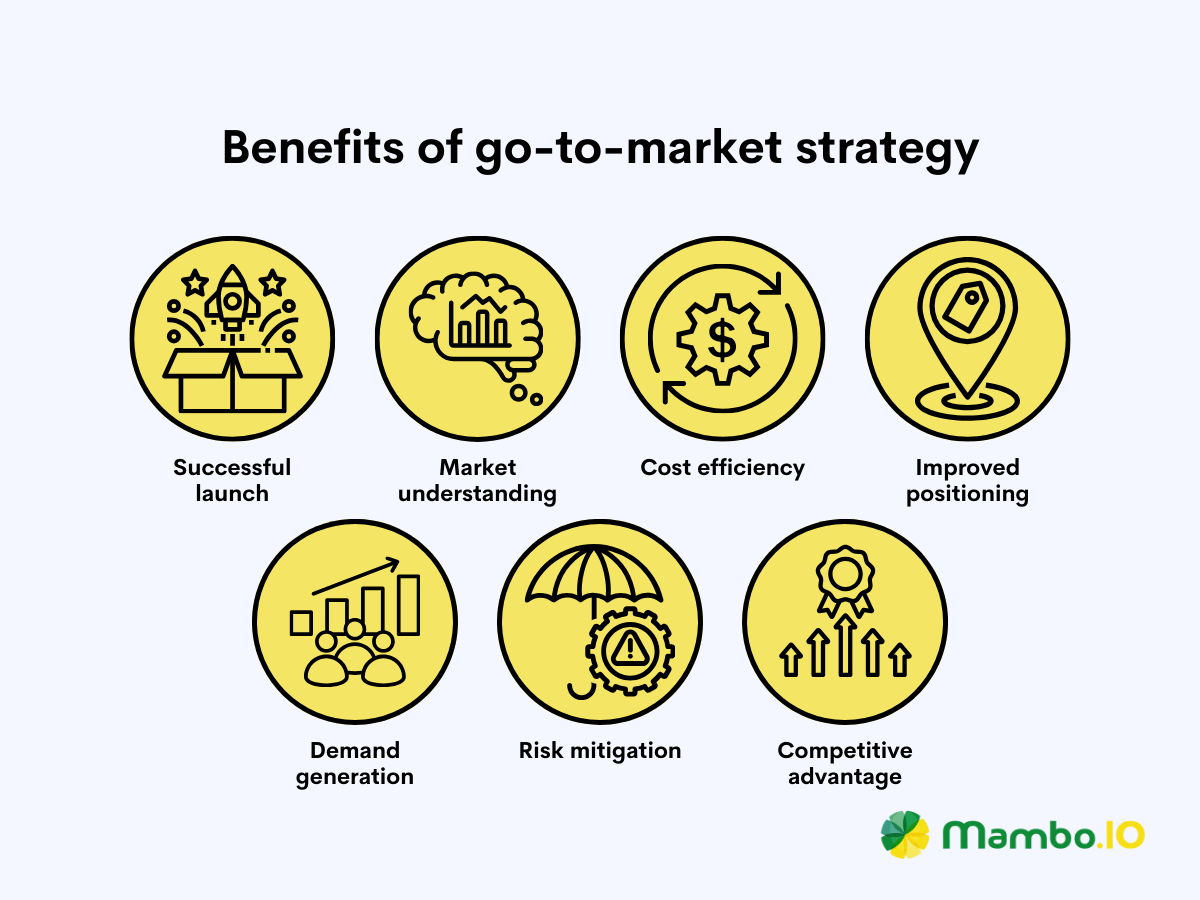
#1. Successful launch
A well-executed go-to-market plan provides a detailed plan covering every product launch aspect. This includes product development, marketing, sales, distribution, and more. This comprehensive roadmap increases the likelihood of a successful product launch. It minimises the risk of overlooking critical elements or making hasty decisions – actions that often lead to launch failures.
#2. Market understanding
Creating an effective go-to-market plan involves thorough market research. This helps businesses comprehensively understand the marketplace they’re trying to penetrate. This in-depth knowledge allows them to customise their product, messaging, and strategy to match the market demands precisely.
#3. Cost efficiency
A critical aspect of this strategy is identifying effective promotional channels that yield the best return on investment (ROI). When executed correctly, businesses can allocate their marketing budget wisely and focus on channels that generate leads and conversions.
#4. Improved positioning
When done correctly, a GTM strategy enables businesses to refine their positioning and messaging before the product launches. Doing so ensures their product resonates well with their target audience.
#5. Demand generation
Generating demand is a primary goal of any product launch. A GTM strategy outlines specific strategies and tactics for creating interest and demand for the product among the target customers. Strategies like marketing campaigns and promotions can increase the likelihood of customers adopting the product.
#6. Risk mitigation
Thanks to GTM strategies, organisations can proactively anticipate potential challenges and obstacles during the product launch or market entry. This proactive approach minimises the chances of costly setbacks and disruptions, ensuring a frictionless product launch.
#7. Competitive advantage
Crafting a well-thought-out GTM strategy enables businesses to position their product uniquely in the market. It identifies what differentiates the product from competitors and communicates this distinct value to its target audience. This competitive advantage helps attract customers who see the product as a superior solution.
Go to market strategy vs. marketing strategy vs. marketing plan
Many people often think that go-to-market, marketing, and marketing plans are the same. Contrary to popular belief, they’re not.
A go-to-market strategy is the highest-level plan that covers all aspects of bringing a product to market, including marketing.
A marketing strategy zooms in on how the product will be promoted and positioned. It outlines the organisation’s marketing objectives and often plays long-term, about years ahead into the future.
Finally, a marketing plan is a detailed document that outlines the specific activities and timelines for executing the market strategy. It’s a battle plan containing the concrete steps to set the marketing campaign in motion.
These three components work together differently to ensure a successful product launch and practical marketing efforts.
Elements of a go-to-market strategy
You must ensure the proper elements are in place to create an effective GTM strategy for your organisation. The most effective approach to creating one involves combining the key factors below.

#1. Product-market fit
This element involves a deep understanding of the problem your product addresses and which specific markets you intend to target. Defining how your offering solves these problems ensures good product market fit.
To ensure proper product-market fit, you’ll need to answer questions like:
- What specific problems does your product address?
- Are any potential improvements required to align with the current market demands?
- How did you validate that your offering meets the needs of your target market?
#2. Target market
Identifying and defining your target market is fundamental to creating a GTM strategy. It involves creating detailed buyer personas of your ideal customers, which helps you understand their pain points, behaviours, and motivations. Once you know your target market, you can tailor your product, messaging, and marketing efforts to resonate with them.
#3. Distribution model
The distribution model outlines how your product will reach your customers. This can be done in many ways, such as websites, mobile apps, or third-party distributors. You must select the most suitable distribution channel that aligns with the product’s nature and the target audience’s preferences.
#4. Competition and demand
Lastly, you’ll need to know the competition that awaits your product. Take time to dive deep into your competitors and examine the other companies offering the same solution. You’ll also need to determine if the market is saturated.
The questions below will help you assess your product’s competitors and demands.
- Who are your main competitors?
- What makes your product value proposition worse than theirs?
- Is your product in demand?
Types of go-to-market strategies
Let’s explore the different types of go-to-market strategies you can utilise.
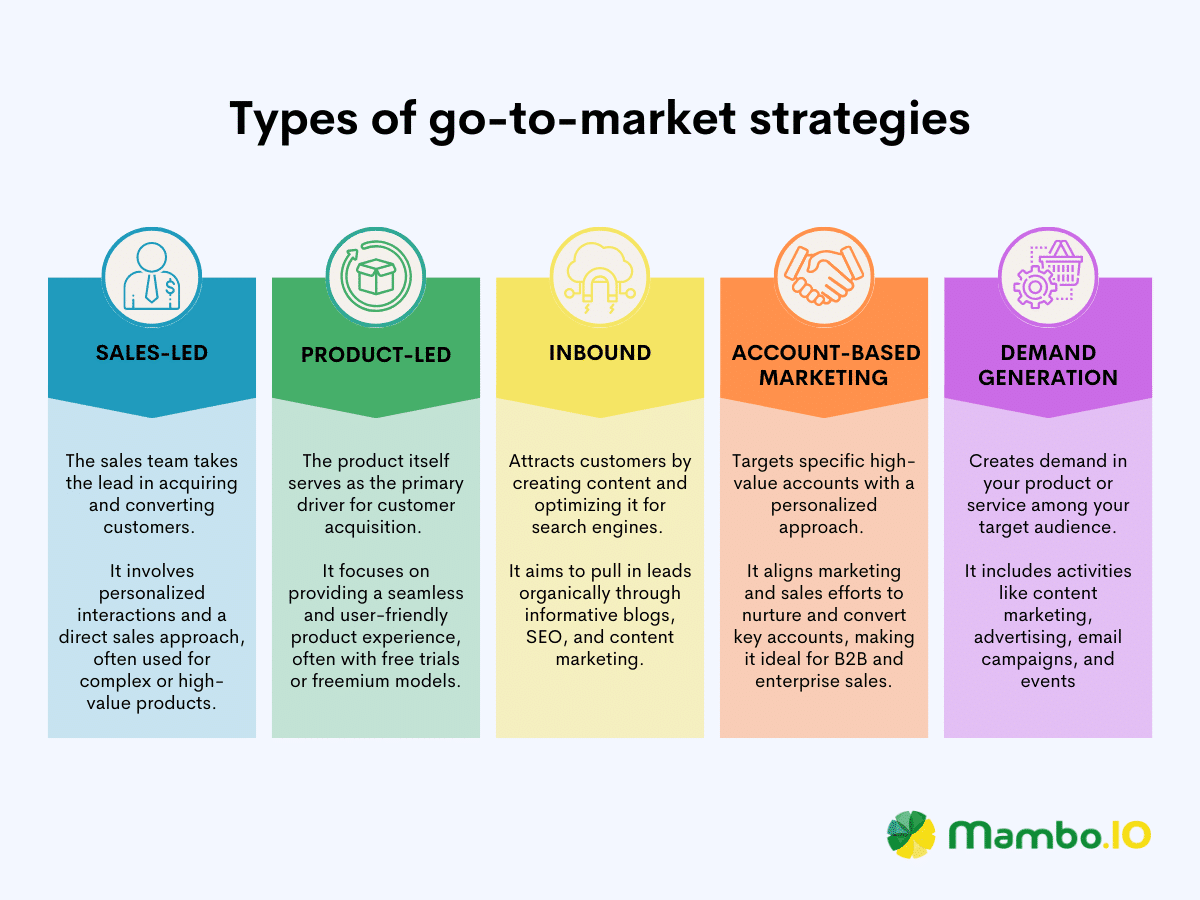
#1. Sales-led
A sales-led GTM strategy emphasises the sales teams’ efforts to drive product adoption and revenue growth. It involves a proactive sales approach where sales representatives directly engage with potential customers to close deals.
This approach is widely used in the B2B industries where nurturing personal customer relationships is critical for closing deals and driving revenue. Additionally, it’s typically used by businesses offering products with complex sales processes or higher price points.
Some companies that have seen success with sales-led strategy are:
- Microsoft
- Salesforce
- IBM
- Oracle
#2. Product-led
Product-led GTM strategy focuses on the product as the primary customer acquisition and retention driver. Companies that employ this strategy offer user-friendly products designed to encourage self-service and word-of-mouth promotion.
In this approach, the product’s inherent value and usability are pivotal in attracting and retaining customers. This approach often works best for large-scale companies that provide products with positive consumer experiences. However, it doesn’t have the same impact if the company backing the product doesn’t have a reputable name.
Regarding product-led GTM, you’re letting the product speak for itself. Doing so can potentially attract and retain customers instead of relying solely on other marketing efforts.
Some notable examples of companies that follow a product-led approach include:
- Netflix
- Dropbox
- Slack
- Zoom
#3. Inbound
With an inbound GTM strategy, you attract and engage customers by providing valuable content backed by a solid online presence. This approach typically uses various forms of digital marketing like content marketing, search engine optimisation (SEO), social media, and more. Its primary goal is to create brand awareness and attract new prospects organically at every stage of the customer journey.
Valuable content is at the heart of inbound strategies. More importantly, it emphasises attracting the right audience at the right time with the right content.
Here are some of the famous companies that follow an inbound strategy.
- Hubspot
- Ahrefs
- Neil Patel
#4. Account-based marketing (ABM)
B2B companies often use account-based marketing (ABM) GTM strategies to target specific high-value clients instead of a broader market segment. ABM strategies are highly personalised and revolve around building strong relationships with selected high-potential prospects. It often involves one-on-one communication and customised marketing efforts tailored to the unique needs of each target account.
This strategy aligns marketing and sales teams to collaborate in locating, targeting, engaging, and closing deals with important accounts. Instead of casting a wide net, ABM strategies aim to precisely target specific key accounts – like fishing in a barrel.
Here are some companies that have seen success by following an ABM strategy:
- O2
- DocuSign
- LiveRamp
#5. Demand generation
Finally, a demand generation GTM strategy focuses on creating awareness and interest in a product to generate demands and leads. This approach employs marketing tactics, including advertising, content marketing, social media, and events. It does so to create excitement and interest around the product a company offers.
The primary goal of companies that use this strategy is to drive potential customers into the sales funnel. They can do so by generating high-quality leads. Unlike a sales-led plan, this one aims to create warm, well-informed leads and exhibit a healthy interest in the product.
Some of the famous companies that use this approach are:
- Uber
- Adobe
How to create a go-to-market strategy
#1. Identify the problem
A successful GTM strategy will need a clear and validated problem statement that resonates well with your audience. To define that, you’ll need to understand your target market. Are they everyday consumers (B2C) or other businesses (B2B)?
You may need to use segmentation techniques like demographic and psychographic analysis to define it. Additionally, you’ll need a compelling value proposition that positions your product as the prime solution. A grand product launch ultimately hinges on solving a specific problem and achieving product-market fit.
#2. Define your target audience
Understanding the customer base is central to any marketing effort. So, you must research and identify the individuals or businesses most likely to purchase your product. Insights from this process will guide your segmentation techniques to ensure that your marketing strategies align seamlessly with your product’s capabilities.
Some of the questions that will help you define your target audience are the following:
- Who is experiencing the problem your product solves?
- What frustrations can your product alleviate for them?
- How much money are they willing to spend to eliminate their pain points?
Two primary methods can help you determine your target market: ideal customer profile (ICP) and buyer personas.
Ideal customer profile (ICP)
An ideal customer profile (ICP) is a detailed and specific representation of your perfect customer. It serves as a focused and strategic approach to identifying the ideal customers who are a perfect fit for your product.
To create an ICP, you’ll need the following characteristics:
- Industry or demographic
- Geography
- Company size
- Budget
- Buying process
- Purchasing decision-makers
- Pain points
- Business goals
- Technologies
- Attributes
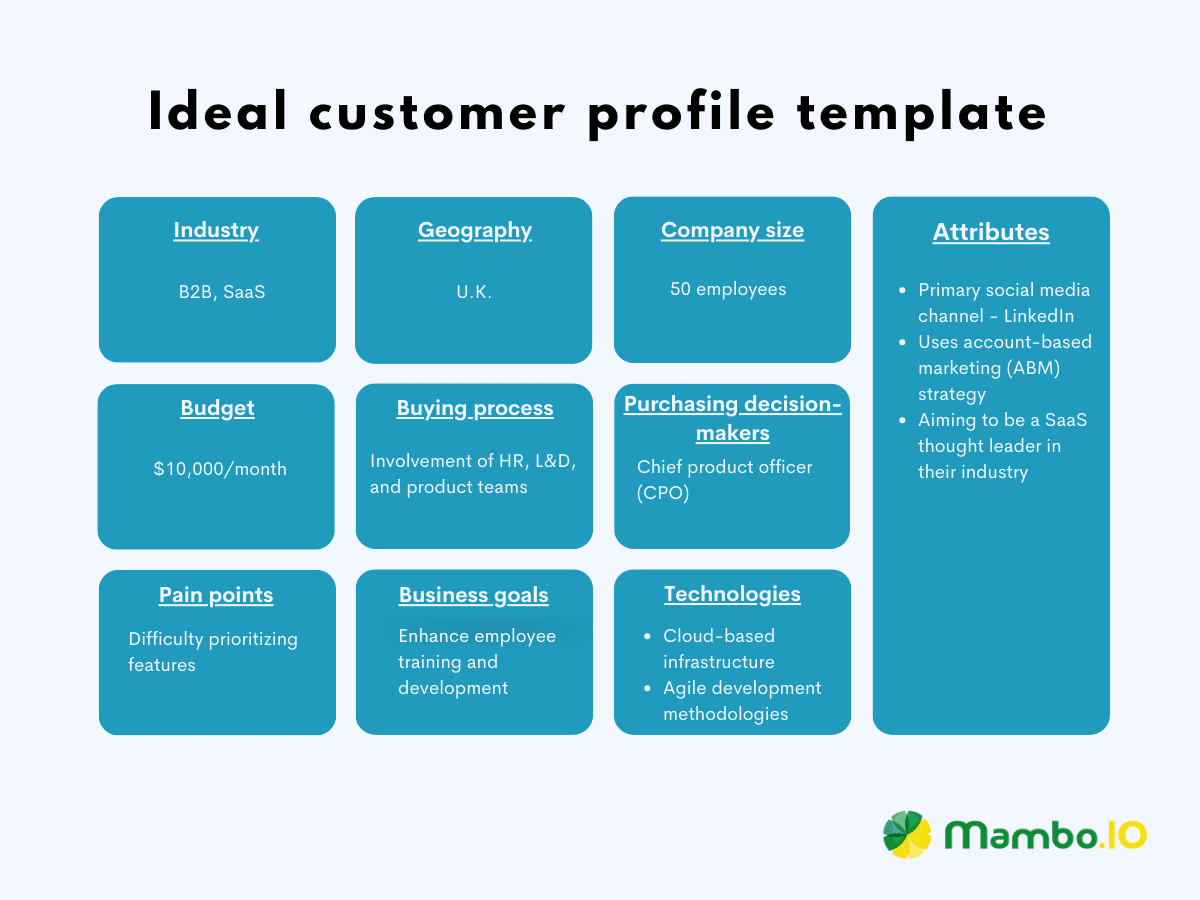
Buyer persona
A buyer persona represents a specific segment within your target audience. It goes deeper than the ICP by diving deeper into your target market’s characteristics, behaviours, motivations, and goals. This is more detailed and humanised to visualise your customers as real people with distinct needs and preferences. This level of customisation and personalisation allows you to resonate with and engage different segments of your target audience.
Here’s what a buyer persona would look like.

#3. Research and assess your competition
Before committing resources to launch your product, you must gauge the demand for your product and your existing competition. Your objective here is to narrow your list of competitors down to a select group that defines your competitive landscape. This task becomes straightforward when introducing a new product as there may be no direct competition. However, this process will become more complex if you’re trying to improve an existing market.
Conduct a competitive analysis
After finalising your list of competitors, you’ll need to evaluate each. To do this, you’ll need to ask yourself the following questions.
- Who are the companies you’re competing with?
- What target audience do they cater to?
- What makes your product better than theirs? What makes your product worse than theirs?
- What do they do well? Where do they lack?
- Is there a demand for your product, or is the market already oversaturated?
By answering those questions, you just did a competitive analysis.
A competitive analysis is the process of identifying your competitor’s strengths and weaknesses. The key steps in this process are to adopt a buyer’s perspective and investigate your competitor’s offerings.
Moreover, this process will uncover their strengths and weaknesses compared to your product. During this scenario, a SWOT analysis will significantly help you.
#4. Identify and test your messaging
Now that you know your customers and competitors, it’s time to decide how to sell your product. What message will you say to entice them to purchase your offerings?
These responses will be different based on the persona you’re dealing with. Because of this, it’s much better to follow an approach customised for your buyer’s persona. In this scenario, you’ll need a valuable tool called the value matrix.
Value matrix explained
A value matrix is a visual tool for assessing and communicating the value of your product to different customer segments. Using this can help you properly position your product in the market. It breaks down a buyer’s persona, pain points, and how your product solves them. Most importantly, it contains a key marketing message that ties the problem and the solution together.
Here’s what a value matrix would look like for a fictional pet adoption platform:
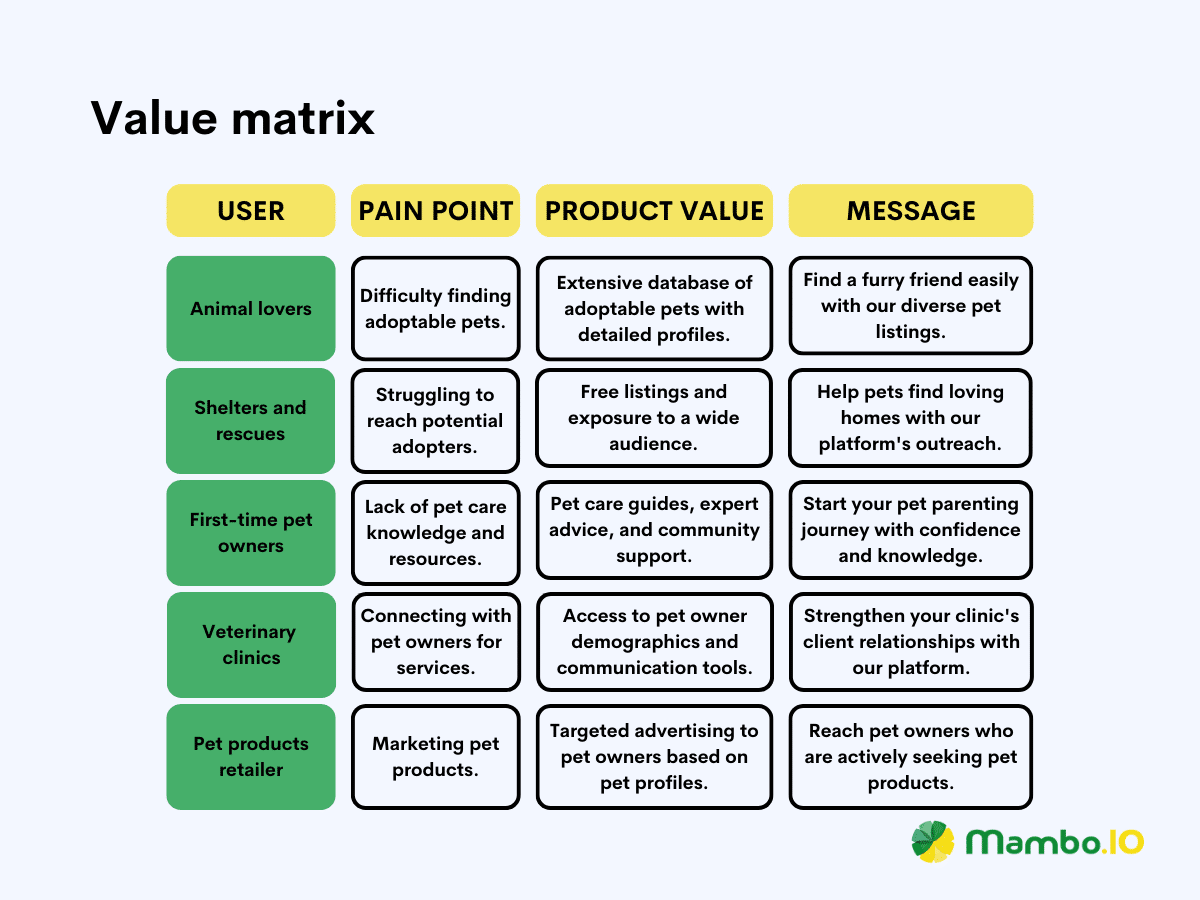
Use this chart to list the pain points your persona experiences daily, along with a solution provided by your product. Then, craft a brief but meaningful message that ties the two together.
PRO-TIP: When making a value matrix, agitate the problem then provide a straightforward solution. Your messaging should act like painkillers to their problems.
Testing your message
With your messaging in place, it’s time to give it a dry run. Start posting your message on various marketing platforms where your users usually spend their time.
To identify the best platform for your use case, advertise your materials on multiple channels like LinkedIn and Facebook Ads. Then, check your conversions to see which platform best suits your strategies. Always invest your money wisely on platforms with higher conversion rates and abandon those with low conversion rates.
#5. Understand your buyer’s journey
Your next move is to understand your buyer’s journey. Do this from two perspectives – the buyer and your organisation. Map their journey and see how they realise their pain points when purchasing. Understanding this process will help you determine what content to deliver to your audience.
The problem with traditional sales funnels
The buyer’s journey is a linear path of awareness, evaluation, and conversion stage. This path is known as a sales funnel, the journey your customers will go through whenever they purchase. It’s usually divided into three parts, namely:
- Top-of-the-funnel (ToFu) – This stage is about creating brand awareness and generating leads through content creation and awareness campaigns.
- Middle-of-the-funnel (MoFu) – This stage involves nurturing leads with valuable information to convert them into prospects.
- Bottom-of-the-funner (Bofu) – This stage focuses on closing deals by engaging prospects with personalised interactions like sales calls and product trials to convert them into customers.

The traditional sales funnel has worked for years, but there’s one problem: it isn’t customer-centric. With this framework, companies shell out resources to convert leads into buyers. However, the customer becomes an afterthought, and there’s little effort towards delighting them and making them your product’s advocate.
So, as an alternative, we’d like to introduce the flywheel model.
The flywheel model – the better way to understand the buyer’s journey
The flywheel model is a framework that emphasises the importance of customer-centric approaches and long-term growth. With this framework, the customer is the centre of the customer journey and not an afterthought.
The flywheel model has three key stages:
- Attract – the stage where companies attract attention using various channels like content creation and social media marketing.
- Engage – The stage where companies build trust by engaging with the traffic they generate.
- Delight – The stage where companies delight their customers by helping, supporting, and empowering them to reach their goals.
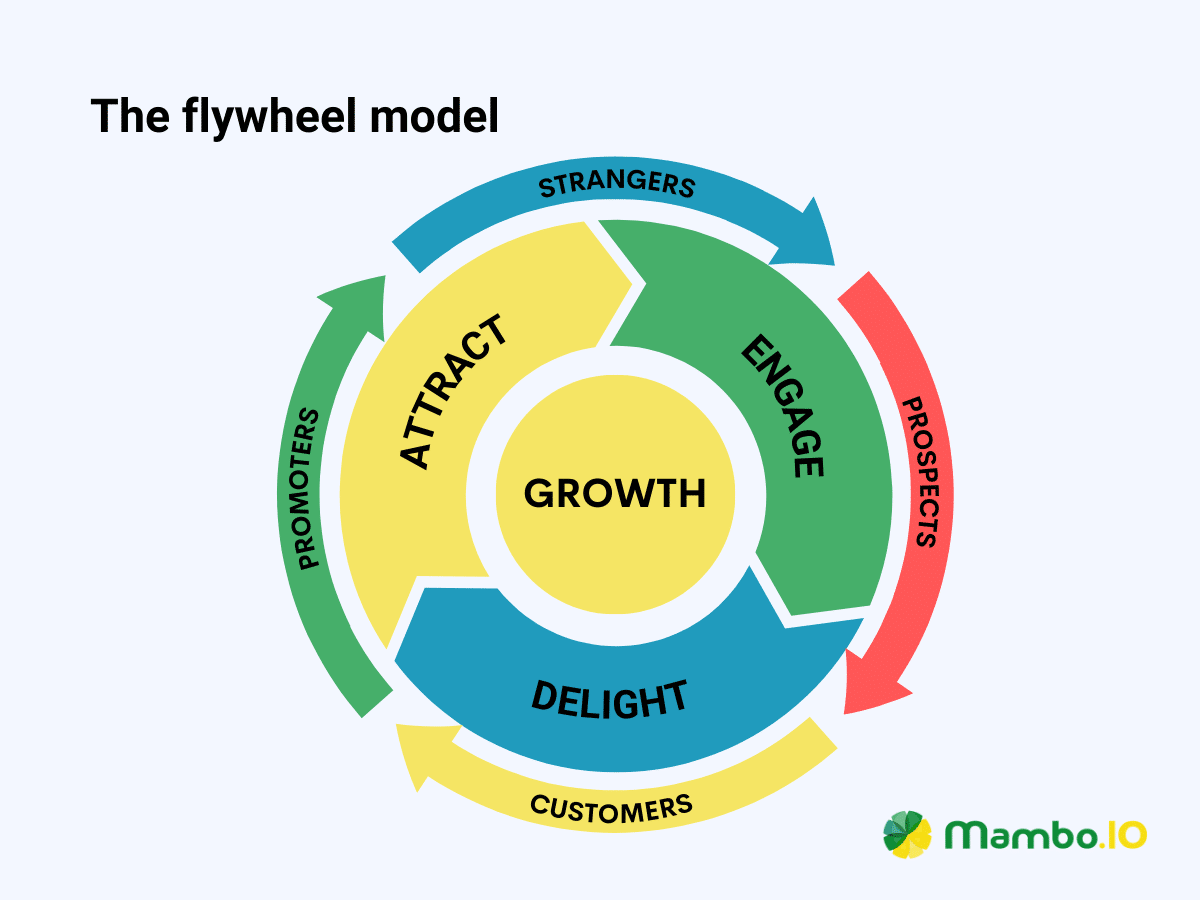
When the customer exits their buyer’s journey using the flywheel model, they’re more likely to advocate for your products. This advocacy will translate to more customers, adding momentum to your efforts like an actual flywheel.
#6. Define your pricing strategy
If you’re considering promoting your product, you better set up your pricing strategy first. To do this, you need a better grasp of how much your customers will pay to address their pain points. You wouldn’t want to sell your product too high because you might not sell anything.
Consequently, you wouldn’t want to sell it too low either unless you want to slice off your profit margin.
A robust pricing strategy can deliver these critical benefits for your product:
- Maximise revenue and profitability
- Attract the right customers
- Standout in the market
- Effective brand positioning
6 most popular pricing strategies
You can choose from six of the most popular pricing strategies for your GTM strategies.
#1. Cost-plus pricing
This involves calculating the cost of production and then adding a desired profit margin.
#2. Value-based pricing
This strategy lets you set the price based on your customers’ perceived value.
#3. Competitive pricing
Following this strategy will keep you competitive as you set your prices close to your competitors.
#4. Penetration pricing
With this strategy, you’ll set up a low initial price and then gradually increase it to improve profitability.
#5. Price skimping
The opposite of penetration pricing, where you start with a high price and then lower it gradually to target different market segments.
#6. Freemium pricing
A strategy where you offer the basic version of the product for free while charging for premium features.
#7. Select your distribution medium
There are many marketing channels you can use as a way to promote your product. When done correctly, these promotions can generate demand, create buzz, and guide potential customers through your marketing funnel (or flywheel).
But before you choose one, understand that there’s no such thing as a cure-all for your marketing concerns. A combination of one or more sometimes works, depending on what works for your case.
Marketing channels to use for a GTM strategy
- Content marketing – Develop insightful blog posts, whitepapers, and eBooks related to your product’s industry and share them on other platforms.
- Social media – Leverage platforms like LinkedIn, Twitter, and Facebook to engage with your audience, share product updates, and run targeted ads.
- Email marketing – Build a segmented email list and send newsletters and personalised content to nurture leads and customers.
- Search engine optimisation (SEO) – Optimise your website for search engines to increase organic traffic.
- Paid advertising – Use Google Ads, social media advertising, and other paid advertising methods to reach a wider audience and drive targeted traffic to your product pages.
- Influencer marketing – Partner with industry influencers or thought leaders to endorse your product.
- Video marketing – Create product demos, explainer videos, and tutorials on platforms like YouTube to engage visual learners.
- Affiliate marketing – Partner with affiliates to promote your product in exchange for a commission on sales generated through their referral.
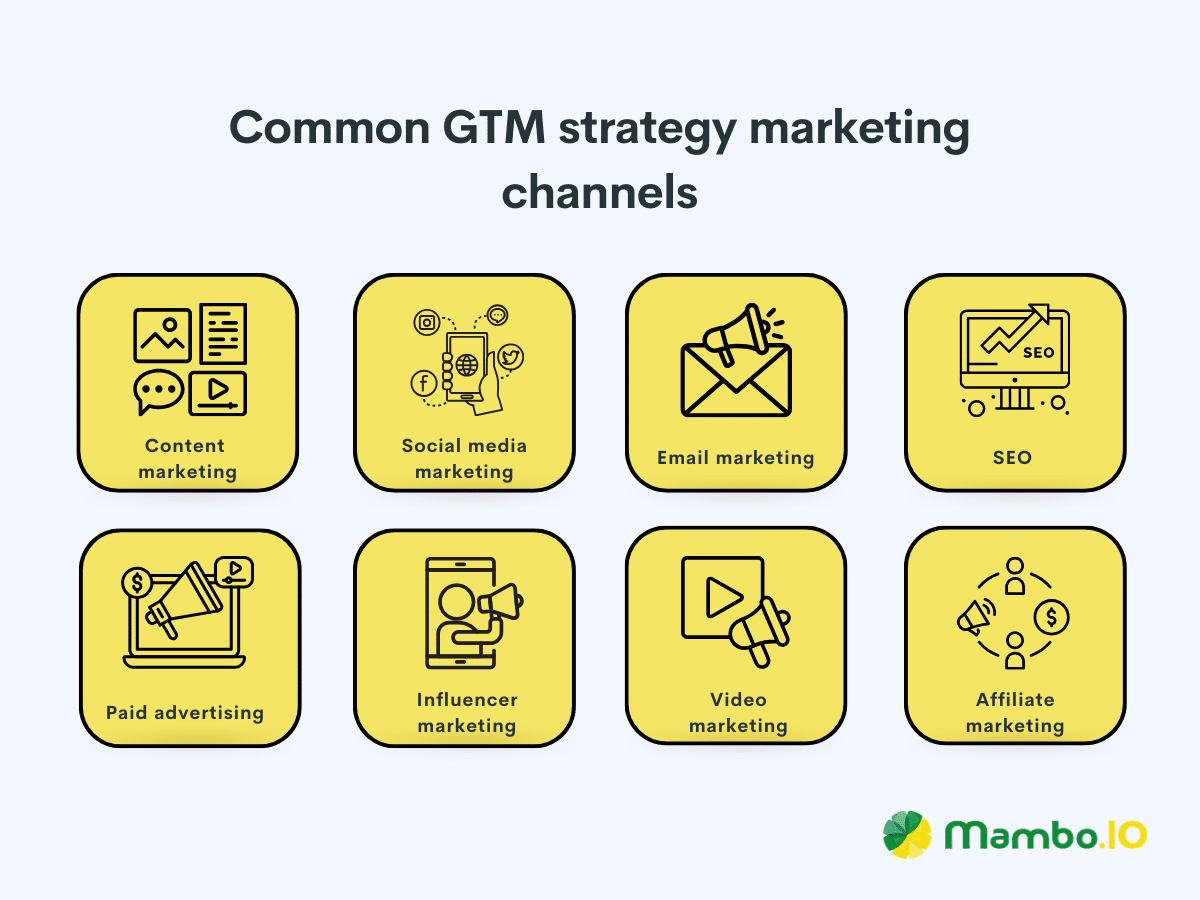
Align with your audience
Your marketing channels should sync with the preferences and behaviours of your target customers. For example, if they prefer using YouTube over Instagram, prioritise YouTube ads in your strategy.
Consider each stage of the funnel
Customers will go through different marketing funnel stages, so tailor your approach to each stage. For instance, use SEO content to attract top-of-the-funnel customers just discovering your product. Middle-of-the-funnel customers who may benefit more from case studies and webinars. Lastly, bottom-funnel customers may need incentives like free trials to commit.
#8. Choose a sales strategy
Again, there’s no one-size-fits-all solution for this. Because of this, you’ll need to consider your GTM strategy’s complexity, scalability, and costs when choosing one.
The four primary go-to-market sales strategies are tailored to specific product types and business models.
#1. Self-service model
As the name suggests, the self-service model enables end-users to purchase independently. This approach is prevalent in e-commerce since customers can quickly discover and buy products online. It works best for simple products with lower prices and high sales volume.
For this model, you won’t need a dedicated sales team, only a marketing team to drive website traffic and conversions.
#2. Inside sales model
The inside sales model involves a sales team that nurtures potential customers to persuade them to purchase. This strategy is excellent for products with medium complexity and price points.
You’ll need to invest in an inside sales team for this model to work. Fortunately, an inside sales team is generally less expensive to hire than field sales reps.
#3. Field sales model
The field sales model is designed for products that are complex and come with high price tags. This strategy targets large enterprise deals, but it also means a lower volume of transactions and longer sales cycles.
This is a high-investment strategy since hiring field sales teams is expensive due to the inexperienced, high-salary employees involved. And while it’s relatively easy to set up, scaling it can be challenging and requires significant time and financial resources.
#4. Channel model
With the channel model, external partners or agencies will sell your product on your behalf. These partners include referral partners, distributors, affiliate partners, and marketplaces, to name a few. It is a cost-effective approach, but it often comes with challenges like the partner alignment and motivation to sell.
Remember, you don’t have to rely solely on one sales plan. You can always mix and match these strategies based on your industry or customer size. But when it comes to startups, it’s wiser to scale gradually than invest in an expensive sales team too early.
#9. Set goals and monitor your performance
As your GTM strategy transitions from an idea to reality, you must monitor your metrics closely.
Here are some of the critical metrics you need to monitor:
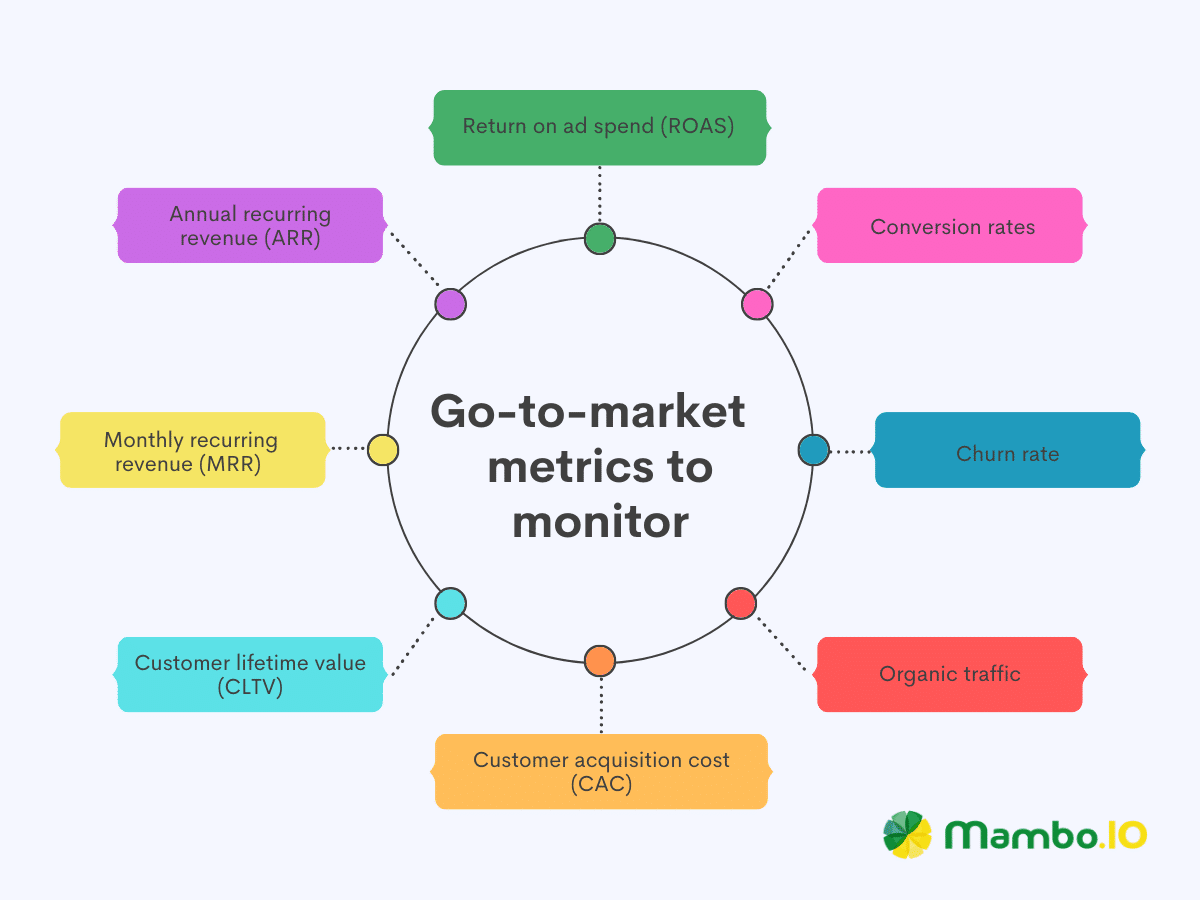
Customer acquisition cost (CAC)
CAC represents the cost you’ve incurred to acquire a new customer. It includes marketing, advertising, sales efforts, and associated overhead expenses. Monitoring this will help you assess the efficiency of your customer acquisition efforts and their alignment with your budgetary goals.
Customer lifetime value (CLTV)
This metric is critical for understanding the long-term value of your customers. Moreover, it guides your decision-making processes when dealing with retention and upselling efforts.
Monthly recurring revenue (MRR) and annual recurring revenue (ARR)
These metrics indicate the predictable revenue generated monthly and annually. Tracking the MRR and ARR will provide insights into your revenue’s stability and the product’s growth potential.
Return on ad spend (ROAS)
ROAS measures the effectiveness of your advertising campaigns by calculating the revenue earned for every dollar spent on advertising. A ROAS greater than 1 means your campaign is profitable. But if it’s less than 1, your campaign doesn’t yield positive returns.
Conversion rates
Conversion rates measure the leads that take a desired action, such as purchasing or signing up for a newsletter. Monitoring them at different stages of the customer journey will help you identify areas for optimisation.
Churn rate
The churn rate is the percentage of customers who stop using your product or service over a specific period. A high churn rate means the business loses more customers than it’s getting because of unsatisfactory products. If this happens, you will need to improve your customer retention efforts.
Organic traffic
This metric tracks the volume of websites or app visitors from unpaid search engine results, hence the term organic. It indicates your online visibility as well as the effectiveness of your SEO. An increase in organic search traffic can signify improved discoverability and content relevance.
#10. Create repeatable processes
Executing a GTM strategy requires ongoing effort and consistency beyond just planning for go-to-market fit. Consistency showcases your business as innovative, fostering FOMO when customers miss releases. Repeatable GTM processes retain existing revenue, reducing customer churn and increasing upsell potential due to trust and satisfaction.
How to create a winning go-to-market strategy
Here’s a summary of the steps to create a winning go-to-market strategy.
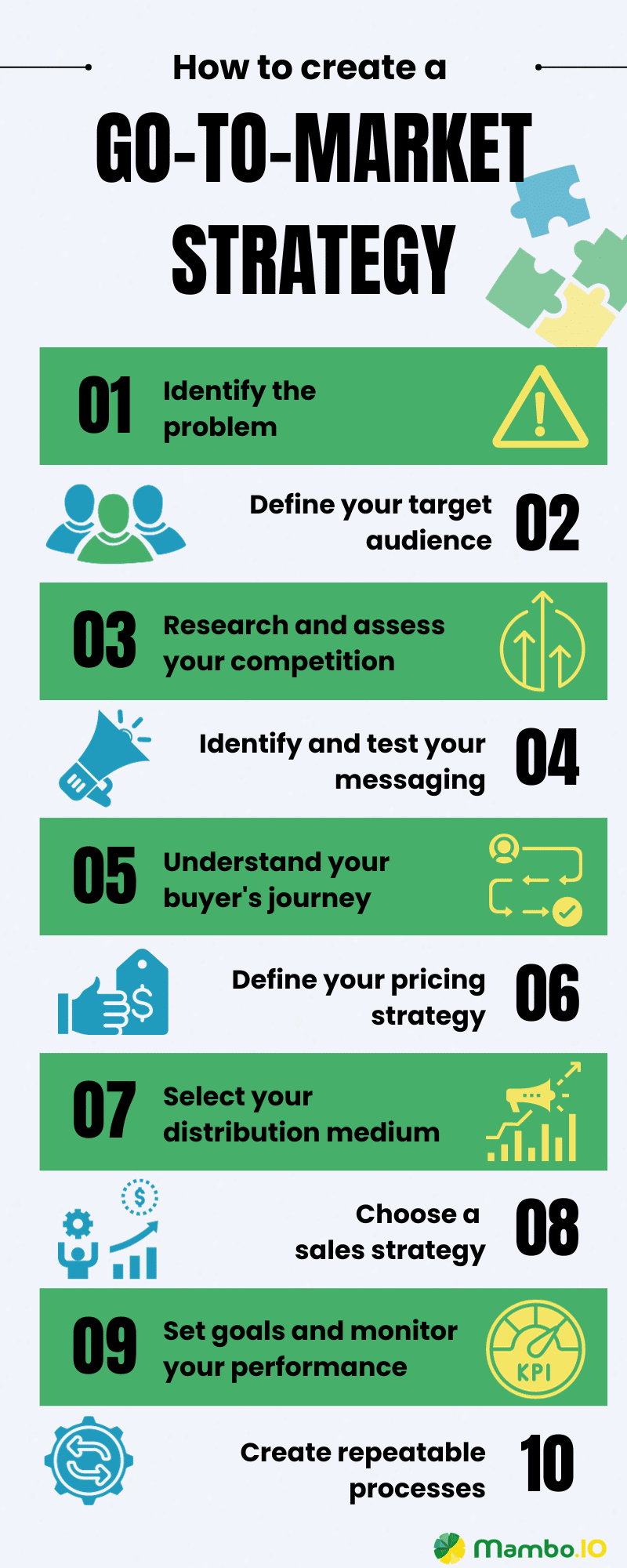
When do you need a go-to-market strategy?
#1. Launching a new product in an existing market
If you’ve developed an innovative product ready to hit the market, then a well-defined GTM strategy is non-negotiable. It will significantly help you introduce something new and capture the attention of your existing target market.
Consider it as an actionable plan enabling you to identify prospects and price the product. It can even help you craft a compelling message and choose the most effective distribution channels!
Ultimately, a GTM strategy ensures your new product isn’t lost in the crowd. Instead, it helps it stand out as a valuable solution to a known problem. With a well-defined GTM strategy, you’re not simply launching a product. You’re doing it with a clear and calculated approach to success.
#2. Bringing an existing product to a new market
Reaching out to untapped customer segments is a bold move that requires careful planning. GTM strategy is useful when you’ve got an existing product, and you’re setting your eyes on new frontiers to penetrate. It assists you in adapting your product and messaging to fit the unique characteristics and preferences of the new market.
More importantly, it ensures your product retains appeal and relevance in the new territory. Doing so makes your expansion journey smoother and more likely to yield positive results.
#3. Testing a new product in the market
Venturing uncharted territory by testing a new product in other markets can be thrilling and risky. In this scenario, a GTM strategy can be your compass.
A GTM strategy will help you navigate uncertainty by providing a structured approach. It will outline how to position your product, set its pricing, and effectively pick distribution channels. It’s all about minimising the risks and optimising your chances of success in this unknown but promising new landscape.
Tips when creating a go-to-market strategy
Are you ready to skyrocket your product and company’s success with an innovative GTM strategy? Before you create this marketing strategy, consider implementing the tips below to ensure the success of your marketing efforts.
#1. Set deadlines and stick to them
Time is precious, mainly when you and your team aim for a deadline. Because of this, you’ll need to define precise milestones and deadlines for your GTM plan. Most importantly, stick to them rigorously to maintain your momentum.
#2. Continuously adapt and iterate
Market conditions constantly change, and so should your GTM strategy. Be agile, gather feedback, and iterate your approach using real-time data and insights. You must always be strategic and driven to improve your processes to adapt continually.
#3. Understand your resource constraints
There’s nothing wrong with being optimistic, but you need to set realistic expectations of what your GTM strategy can achieve. Recognise the limitations of your resources and tailor your strategy to make the most of what you have.
#4. Optimise your pipeline for higher conversions
Setting a sales strategy and demand generation processes is not enough to drive growth for your company.
If you want your GTM strategy to be successful, you must identify and optimise the bottlenecks in your sales pipeline. Streamline it by eliminating any frictions and zero in on improving the conversion rates at each stage.
Remember that sales are a numbers game. So, you’ll need to make your pipeline as smooth as possible to make significant progress.
#5. Analyse and shorten the sales cycles
Avoid lengthy sales cycles by analysing the steps involved and expediting the process without compromising quality. Focus on ongoing lead nurturing and proactive objection handling. Most importantly, keep nurturing leads throughout their journey and preemptively address common objections to prevent them from arising.
#6. Reduce customer acquisition cost
Find cost-effective channels and methods to acquire new customers to sustain your acquisition costs. Eventually, you’ll also need to optimise your processes too. Optimising your customer acquisition cost will be expensive, but this is much better than losing more money in the future.
#7. Tap into your existing customer base
Your existing customers are a goldmine because their loyalty to your brand will help you expand your reach. Use sales tactics like cross-selling, upselling, and renewals to leverage this opportunity and gain more revenue.
#8. Retain and delight your customers
Happy customers are your best advocates. For this reason, you must focus on delivering exceptional customer experiences to foster loyalty and reduce churn. This is also the best opportunity to use the flywheel model we introduced earlier.
Examples of successful go-to-market strategies
A go-to-market strategy can be your company’s key to sustainability and profitability when implemented correctly.
Look at some of the companies below, all of which used their GTM strategies to reach the heights of success.
#1. Microsoft
Microsoft is one of the authorities when it comes to driving digital transformation across industries. That’s because their go-to-market strategy is deeply rooted in understanding and providing value to their end-users.
More importantly, they’ve developed tailored solutions that resonated powerfully with their customers, making their offerings even more attractive.
This is a clear lesson for product managers. Understand what drives your customers and tailor-fit your solutions around their needs and preferences
#2. Tesla
When you think about electric cars, Tesla is likely the first brand that comes to mind. Honestly, we can’t blame you. Their popularity is one of the products of their remarkable go-to-market strategy, one that took the world by surprise.
Typically, companies like this would concentrate on making a small market-ready prototype that the public can quickly adopt. However, they flipped the script and immediately focused on targeting wealthy buyers with the Roadster, which sold for $109,000. They were also known to provide top-of-the-line buyer experience, from ordering and customisations to upgrades.
#3. Fitbit smart coach
When Fitbit launched the Smart Coach personal training app, they had only three simple objectives. Those are to increase their subscription revenue, boost their subscription attach rate, and build brand awareness.
Their campaign specifically targeted people who owned Fitbit devices, and they used both paid and owned channels to reach them. Using this strategy, they’ve accomplished those objectives plus around $192 million in revenue.
#4. Canva design school
Canva’s move with Design School is a prime example of an inbound GTM strategy done right. For those who don’t know, the Design School is an online space within Canva that helps users learn graphic design. The content inside this learning platform is so great that Canva got more sign-ups and more revenue.
#5. GoPro
GoPro is known for catering towards adventure-seeking audiences. Since they understood their customers so well, they implemented a targeted campaign on Twitter for people to share their stories. The user-generated content from this #HomePro campaign leads to higher product demand without them promoting the product itself.
Go-to-market strategy templates
We understand the complexity of creating an exceptional go-to-market strategy for your organisation. To simplify things, we recommend you use ready-to-use templates. We’ve gathered the best templates to help you make the best GTM strategy your company needs.
An effective go-to-market strategy is key to success
A winning go-to-market strategy can definitely skyrocket a company to success. However, creating one is challenging because you’ll need to consider many factors, such as in-depth customer and competitor understanding. Implementing a successful go-to-market strategy will require a joint effort between your team and stakeholders. When these people are all hands on deck, the chances for the GTM strategy to succeed are high.
At Mambo.io, we’re always rooting for your organisation’s success. That’s why we offer a solution to one of the most common problems many industries face nowadays – user engagement. With our gamification platform, businesses can improve their user engagement without losing focus on their product or service.
Book a demo today to learn how your organisation can benefit from gamification!
Download your free
“Gamification Guide”
Get your PDF now and start transforming your approach to digital engagement!
Latest Posts
Machine Learning In Finance: 12 Essential Applications
The impact of machine learning on finance is significant. Thanks to this technology, financial institutions are now equipped to make efficient decisions. Through the analysis of data sets, machine learning […]
How To Create Interactive Compliance Training For Bank Employees
Banking compliance training isn’t just another task. It’s the stage where everything else performs. Banks must navigate a myriad of regulations and laws. After all, this is a trust-driven, high-stakes […]
How Fintech Apps Are Using Gamification To Increase User Engagement
Discover how gamification in fintech is revolutionizing financial engagement, making banking fun & boosting user loyalty.





